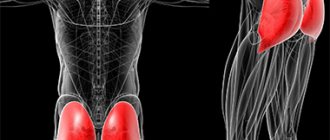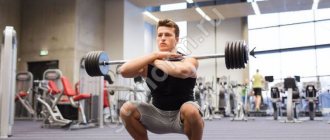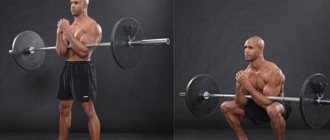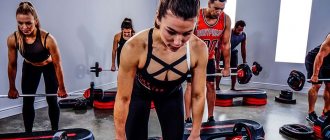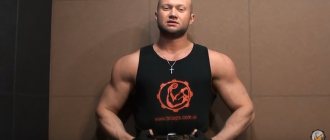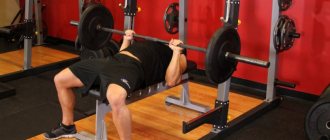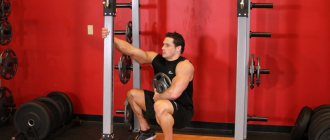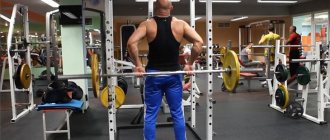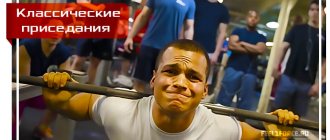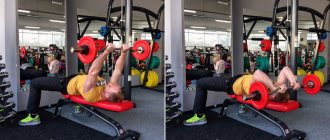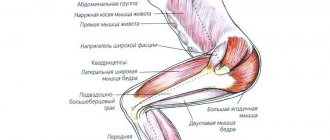Home › Exercises › Knee Squats
What should a girl do if she is a “complete zero” in the gym, but really wants to pump up her butt. There is only one answer - experiment. Today we will look in detail at one atypical exercise. Namely, knee squats. And we’ll find out how effective it is and whether it’s worth including it in your training program.
Of course, when a girl comes to the gym to pump up her buttocks, any trainer will immediately prescribe her a classic squat. In the end, it turns out that she wanted to enlarge her butt, but got bigger legs. This situation occurs very often.
And this doesn't mean that squats are a bad exercise. Everything is poison and everything is medicine. In other words, we need to feel exactly what we are doing in this or that exercise. The classic squat with an emphasis on the buttocks is a difficult exercise to perform.
Therefore, if you are new to exercise machines and exercise without a trainer, then it is better to pay attention to easier exercises. Kneeling squats are just one of them.
What muscles work
Knee squats can be classified as both basic and isolated exercises that are aimed at working the buttocks.
The complete atlas includes the following muscle groups:
- targeted – gluteus maximus;
- synergists - quadriceps, hamstrings, rectus abdominis, spinal extensor muscles.
NOTES
· In theory, the depth of a squat is determined by the strength of your lower back. At some stage of movement, the lower back muscles lack the power resource to keep the lower back straight. As a result, the lumbar region of the spine “folds” due to deflection inward. The greater the deflection, the greater the risk of severe lower back injury. Ask your partner to watch you from the side and note the optimal depth of the squat that does not threaten injury.
· The main target of front squats is the quadriceps. But when you get low enough, you also activate the knee erector muscles (gluteus maximus, biceps femoris, semitendinosus, and semimembranosus).
· Be sure to exhale immediately after completing the most difficult part of the climb. The fact is that at the moment of straightening the body, intrathoracic pressure increases sharply. This is what needs to be lowered by exhaling.
· During all phases of movement, maintain constant stabilizing tension in the back muscles. Otherwise, at the moment of stopping in a squat and at the beginning of the rise, the spine will “spring”. And this again threatens injury.
· Lifting speed can be varied. But lowering into a squat should always be emphasized slowly.
· Look straight ahead. This will help you keep your back straight.
· Squats indirectly strain the abs. If the weight is too heavy, an extremely strong, spasmodic contraction of the abdominal muscles is possible. This necessarily entails “rounding” of the back, and then spinal injuries.
Benefits of Knee Squats
Knee squats have some advantages over classic squats:
- enlarge the buttocks without enlarging the legs;
- develop strength in the hips and buttocks;
- help overcome the “plateau” in basic squats;
- relieve stress from knee joints;
- strengthens the muscles of the lower back.
Note. This exercise is classified as “explosive”, which allows it to be used in a type of training such as pumping. The purpose of which is to fill the muscles with blood and, as a result, inflate them, which will make them visually larger.
Smith machine lunges
Lunges with a barbell are a basic exercise for working the muscles of the legs and buttocks. Smith machine lunges help you master the technique of performing this exercise. Muscles worked: quadriceps, gluteal muscles and hamstrings.
- Prepare for the exercise by setting a barbell on a Smith machine at a height just below your shoulder height and hanging plates of the desired weight.
- Stand under a barbell with your feet shoulder-width apart.
- Place the barbell so that it rests comfortably on your back muscles, but not on your neck. You can put a towel under the bar if it’s not comfortable.
- Grab the bar with a wide grip.
- Bend your knees slightly and straighten your back. Straightening your legs, remove the barbell from the rack.
- Place your right foot forward, left foot back. Now you are in the starting position.
- While maintaining balance, perform a squat - bend both knees, back foot on tiptoes, front foot firmly pressed to the floor. The knee of the right leg should not extend beyond the line of the toes.
- Return to the starting position.
- Repeat as many times as necessary, then perform the exercise with your left leg in front.
Materials used: https://www.bodybuild.ru/5597-poperemennye-vypady-vpered-v-polozhenii-stoja-so.html
Technique for performing knee squats
The exercise falls into the “easy as pie” category, but it also has some features. The technique is as follows:
- Set the bar to the desired height.
- Place the folded mat on the floor under the bar.
- Get down on your knees with your shins parallel to each other, shoulder-width apart.
- Place the bar behind your head at the bottom of your trapezius and remove it from the supports.
- Squeeze your shoulder blades and tighten your abs.
- As you inhale, begin to move your buttocks back until they touch the muscles of your lower leg (if stretching allows, you can go lower).
- Without pausing, exhale and return to a vertical position.
- Repeat the exercise a specified number of times.
Before performing, be sure to do a warm-up, since this exercise puts a high load on the spine, namely the lower section. If the lower back muscles are tight, it will be difficult to lift weights.
On a note. Any squats, including kneeling ones, are best done after hyperextension. Your back muscles will be well warmed up and it will be easier for you to work with heavy weights.
Execution options:
- free weight knee squats;
- knee squats in Smith.
Knee squats can be done either with free weight or in a Smith machine (most often). In the first case, all muscle groups are better loaded. In the second, the gluteal muscles are better emphasized, since the movement follows a strictly given trajectory (at least many people think so).
Interestingly, the Smith machine was originally conceived as a simulator for working out lagging muscles. Then it was taken over by newcomers with unproven equipment. And now most of the exercises, including basic ones, are performed exclusively in Smith.
If we consider the trajectory of movement, which will be physiologically correct, then the bar should not go straight, but along an inclined path. That is, Smith squats cannot be technically performed correctly, where the load is vertical.
What to pay attention to
To make the exercise as effective as possible, pay attention to the following points:
- When squatting, go as low as possible to give your gluteal muscles a good stretch.
- Lower slowly and rise quickly by pushing out.
- Hold in the top position for 1-2 counts, squeezing your buttocks.
- Lower as you inhale, rise as you exhale.
- Keep your back straight at all times.
- Do not place your knees directly under the bar, but bring them slightly forward.
- Don't look down, look forward so as not to break your technique.
- Choose the right weight so that the exercise is effective and does not cause injury.
BASICS
There are a wide variety of different squat techniques. All of them come from strength sports: Bodybuilding, Powerlifting, Weightlifting (Weightlifting), and various “other sports” add a little to the general treasury. Here, for example, is a crouching dragon =)
We will not divide them according to the above-mentioned criteria for preschoolers, but will divide them by style of execution and by goals, and then we will have JUST TWO GROUPS:
- Pelvic-dominant style
- Knee-dominant style
It’s too early to think about what these incomprehensible terms mean.
How effective are knee squats for the buttocks?
According to some studies, knee squats have shown better results in the degree of gluteal muscle activity compared to other squats.
In theory, this may be true, but in practice, it’s better to try everything. Kneeling squats, although they are conditionally basic, are, in my opinion, worse than a classic squat with the pelvis pulled back and cannot provide the same effective muscle growth. To do this, just compare the angles in the classic version and in squats from the knees.
But such incomplete squats practically eliminate the work of the legs, which means that almost the entire load falls on the buttocks (albeit not so powerful). There is some advantage to this. And it’s difficult to make mistakes in this case.
Note. I would recommend this exercise more for inexperienced girls. And for those whose naturally quadriceps grow faster than their buttocks.
In general, basic exercises have always been and will be the best for building high-quality muscle mass (which will not go anywhere if you suddenly give up training for a month). Therefore, knee squats should be considered only as an addition to visually fill out the buttocks and give them shape.
BASIC RULES:
Rules that, as they say, are “no brainer”, but to me, let’s say, a lot of what is “no brainer” is not clear to me! I hate hedgehogs! Assholes are too smart. Therefore, let us repeat:
— The height of the racks should be in the middle of your chest.
— Setting the feet. Turned outward from 30 to 45 degrees. The knees point towards the socks.
— The width of the legs is slightly wider than the shoulders. If it’s too wide, it overstrains the pelvis at the bottom, which in principle is not bad for girls; if it’s too narrow, it interferes with the stretching of the adductor muscles of the thigh.
— We go down as far as stretching allows, but at the top we don’t fully straighten our legs. We do not insert the knees so as not to miss the load and injure the menisci.
— We rise upward by lifting the pelvis upward, and not forward!
— If you have positioned the bar correctly, pulled your buttocks back and squatted, the bar will be in the middle of your foot:
- No matter how much experience you have in this exercise, the first approach is ALWAYS performed with an empty bar. ALWAYS, or even with your own weight.
- Grip width. The wider the grip, the less static load on the shoulders and back; the narrower the grip, the greater the load. The choice is yours. In the first case, only the legs work, and this is correct; in the second, the bar does not cut into the back.
- The back should ALWAYS be straight. No arching in the lower back. The lower you go, the stronger the twisting force on your lower back. This needs to be controlled
— The hands should not take the load, they are only used to stabilize the barbell on the back.
— We always step back from the counter. To put the barbell in place, we step forward. And not vice versa, i.e. We stand facing the counter and our backs to our friend
— There is no need to return the barbell to the racks by bending forward. You need to approach the racks until you touch the bar and lower it down. It's like an extra repetition.
-Do not lift your heels off the floor.
— When lowering, INHALE, when RISING, exhale. We NEVER hold our breath.
— A proper squat does not cause tension or pain in the lower back and knees.
- You can't do anything through pain.
— The bar moves strictly up and down, without any side deviations. This means that when squatting, the bar should “draw” a straight line, perpendicular to the floor, and the back tilt is carried out only to the extent that it is necessary to balance the abducted pelvis, no more.
HERE'S A VIDEO OF HOW TO LEARN TO SQUAT
Variety and mix
Lumberjack squats can be used as an alternative to regular squats if you can no longer do them or just want variety.
They are also a great option if you want to increase the number of days per week you squat without repeating the same squatting style too often. Try using them at different stages of your workout or add them for extra intensity during lower body workouts.
see also
10 incentives to start walking 10,000 steps a day
They are a versatile exercise and can be worked with a variety of sets, reps and tempo choices. Happy training!
Header photo: www.weightwatchers.com
There are options
If you move away from training the lifter squat, and stop at the “healthy” fitness option, I would recommend tilting your torso lower towards your knees (the floor) and raising your butt a little higher, or rather, not lowering it below this point. As in the picture number (II).
If you squat with a straight vertical back, then your knees “go” forward and your butt down. Therefore, at some point, it seems to you that the muscles are not working and you are trying to sit even lower. By the way, this squatting technique also exists. This is a pylometric squat.
- squat with jump. It is understood that his goal is to jump out and throw his body as high as possible. It is impossible to squat with any large weights with this technique. That is, this is a completely different squat.
There are also front squats
. We can say that in the first 1/3 of the movement from top to bottom, you do exactly that, although the bar is behind you. But due to the fact that it is in the wrong place (too high) on the neck, that is, the center of gravity is greatly shifted forward “almost a frontal squat”. I would not recommend that anyone do front squats until you can do classic, safe fitness squats with confidence and proper form. So, this is a pure knee-dominant exercise. And such an exercise is always critical for the knees (not for advertising, but for the benefit - listen to the podcast about knees, I’m talking there about how to make training safe for the knees). And our knees are “critical” in 80% of all students.
This is not a random repetition of the picture. This was intended so that we could return to this body position and discuss the main mistake. Let's look at this position, here the body position is very close to a correct deep squat, when the main weight of the body shifts back and the torso leans forward. If they are close to correct, then what spoils the whole picture and the entire biomechanics of movement and this particular position?
Right! Stopping! (1) – The red line schematically shows the placement of the “far” leg – foot, lower leg and thigh.
Here in this photo, incorrect placement of the feet clearly shows how this creates a completely incorrect posture and a traumatic bend angle of the knees and feet (1):
The green strokes (2) clearly show the diagram of the location and bend of the person’s knees in the photograph (1). And the blue strokes (3) are how it should be.
The width of the feet is always individual. It depends on the individual’s physique and height
.
We can give very conditional advice - the taller you are, the wider your heels should be.
.
The toes should be slightly, very slightly turned outward. A stronger turn of the toes is allowed in certain exercises (completely different from this), for example, in a sumo squat, where the legs stand very wide, much wider than in a regular squat, but the toes are also spread 45 degrees outward.
Here is an ideal example of foot placement and knee position at the bottom of a squat:
The feet are turned outward almost imperceptibly (1). The knees, at the bottom of the squat, are exactly above the middle of the foot (closer to the heel). Simply put, the correct placement of the legs can be determined at the bottom of the squat as follows: the closer your shin (shin bone) is to a position perpendicular to the floor in all planes, the more correct the placement of the feet in the squat. The body weight should be on the heels and on the outer edge of the foot. The blue lines depict a kind of “power frame” formed by the outer side of the foot and legs up to the hip, which keeps your movement stable.
Conclusion or “what to do?”
1. Determine for yourself the correct placement of your feet. Look at the position of the shin at the bottom of the squat. It should be close to “almost vertical”.
2. Practice squatting without weight on a bench far behind you. It should be mid-calf height or lower. Step platform, for example. Pull your butt towards her, as if you want to sit on her, stretching your arms forward. This is the correct squat. If you don't lean your body forward enough, you'll simply fall backward.
3. When points 1-2 are clear and performed confidently, take the barbell and try to squat with it on a low bench from behind. First, completely, then hovering over it for a couple of seconds and, without sitting down completely, stand up. Here it is clear what I mean.
4. Find the right squat weight for you. This is the weight with which you can do 4-8 repetitions in 4 sets. I think it’s definitely no less than 36 kg. The barbell weighs 20 kg, plus 16 (8 kg on each side). Warm-up weight – bar without weight. Your Elena,
Subscribe to Zozhnik on Facebook:
Or, and we'll keep you posted.
Tuesday, 12/17/2013
Starting position during squats with a barbell on your shoulders
- The bar needs to be installed at such a height that you can remove it by going under it with your legs slightly bent and then straightening them vertically. You should position the barbell on the trapezius muscles or at the very bottom of the trapezius muscles.
- Your hands should completely grip the barbell with a closed grip. The grip width is wider than the shoulders. You should not take it too wide - there is a risk of losing balance. Do not take it too narrowly - dangerous strains will arise in the wrist joints, shoulders and lower back; if you have a lot of weight, it will be difficult for you to balance the loaded barbell. You will only find the optimal grip width with experience.
- Remove the barbell exclusively by straightening your legs, while keeping your back vertical and tense, with a natural arch (this protects your spine). Don’t try to dive under the barbell, bending over with your body and putting your head under the barbell, while pulling the barbell back to the starting position with your back - you don’t want unnecessary dangerous tension in your lower back.
- Take a step or a few steps back. This is an axiom. Never step forward, otherwise at the end of the set you will be forced to back away with the barbell on your shoulders in search of barbell racks - this is unsafe.
- In the starting position, the barbell is at the same vertical level with the middle of your thighs and heels, as well as the stops.
- Foot placement is very important. And here you will have to experiment for a long time before you find the optimal width for placing your feet and spreading your toes to the sides. We are all designed differently by nature, so success in squats and working the truly targeted muscles rests with you. Master everything down to the smallest detail, start building a powerful house from a small brick.
General recommendations look like this: the width of your feet is wider than your shoulders. The toes are spread out to the sides by approximately 35°. This will allow your knees, hips and toes to be in the same plane during squats. It is unacceptable for your knees to come together during squats or “go to the sides.” The movement must be in one plane.
Fix your gaze at one point, your chin always parallel to the floor. The shoulder blades are brought together as much as possible and form a muscle layer under the barbell, the chest is forward, there is a natural deflection in the lower back. The body is tense.
How to learn to squat?
So, how to squat correctly to pump up your buttocks? The exercise for pumping up the butt is not difficult, so mastering the algorithm of actions will not be difficult. Train regularly and do squats carefully. Follow these steps:
- Take a standing position, place your feet slightly wider than shoulder width;
- move your shoulders back, make sure that your back does not arch, since the entire load will go to the lower back, and not the gluteal muscles;
- Bend your arms at the elbows and place them on your hips or stretch them forward with your palms down. You can also close them at the back of your head only so that your elbows point to the sides;
- point your knees in different directions and begin to bend them;
- lean forward a little, move your pelvis back, imagine that you are sitting on a chair;
- try to squat as deeply as possible;
- try to direct all your weight to your heels to pump up the necessary muscles.
Having figured out how to squat correctly to pump up your butt, you need to decide how long the workout will take. Spend 20-30 minutes pumping. Start by doing a few sets of light weights to warm up your leg muscles. Then do 4-5 working sets of 8 to 15 reps each.
Many people expect to see results within a week, but this does not happen. The time it takes to change the shape of the buttocks depends on the individual characteristics of the person and his physique. With diligent training, the first changes can be noticed in at least a month.
Squats for knee problems
If you notice that during regular squats or squats with a load, pain appears in the knee joints or in the back, the best way out of the situation is to replace this exercise with a bench press. Of course, you should first consult a doctor or trainer.
Everyone else needs to remember that no machine will be as effective as squats. Equipment can only act as an addition to the basic exercise. The main drawback of exercise machines is that they isolate the work of certain muscles, transferring the main load to certain muscles.
Mistakes when performing squats
Ignoring warm-up
Before performing any exercise, not just squats, be sure to warm up. It helps to warm up the body and speed up blood circulation in the body, as a result of which exercises will bring more productive results, and joints and muscles will be prepared for work. Also, after warming up, it is unlikely that you will get injured. The optimal warm-up would be brisk walking on a treadmill and jumping rope. If you want to exercise with a load, first do squats without it, and only then increase the load.
Shallow squats
Of course, this does not mean that squats with thighs that are parallel to the floor are incorrect. However, they are not as effective as deep squats. Lowering your hips below your knees is more effective. In this case, not only the buttocks work, but also the posterior thigh muscles, calf muscles and iliacus muscles. You can correct the situation by spreading your legs wider. This will help balance your balance and warm up even more different muscle groups.
Knees come together
This may happen because you are still a beginner and your muscles are not so strong. However, you still need to do the exercise correctly. It is better to do fewer exercises, but with the correct technique. To correct the situation, you need to perform squats with a mirror in front of you, and make sure that your knees do not come together or spread apart.
Throwing the body back
Always keep your weight on your heels. A beginner should try to squat so that when straightening his knees, he can easily lift his toes off the floor. In this case, the body will always remain in the correct straight position.
The pace is too fast
A novice athlete should not perform exercises too quickly. When doing squats without weight, it is better to monitor your technique, perform repetitions slowly and breathe deeply.
